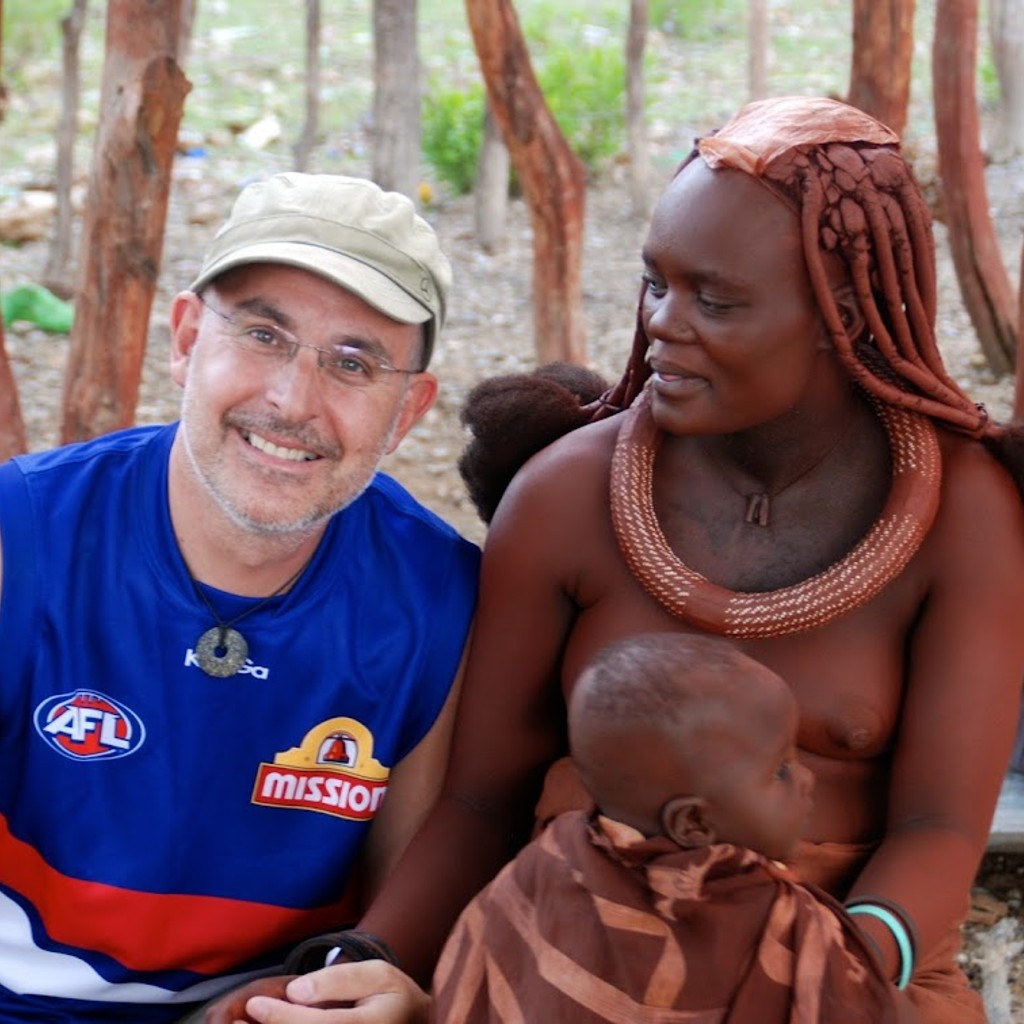
The Sacrifice
The young boy couldn’t have been more than seven years old; he had a shaved head except for a small plait that trailed down his back almost reaching his tattered loincloth. I watched fascinated as he carefully picked up the knife, held down the animal and slit it’s throat. There was a slight flinch from the stricken goat but no cringing or hysterics from the boy; clearly this was all part of his routine. Once the blood stopped pumping from the severed artery the boy and his father expertly butchered the animal by which time I’d lost interest in the whole affair and quietly retreated.
The Beauty
Anyway I’d promised one of the single women that I’d join her on her daily trek to fetch water for the village. We set off barefoot enjoying the coolness of the sand, as it was still early in the day. The rugged landscape of steep mountains interspersed with open plains was stunningly beautiful in the early morning as it transformed from dark sinister shades into softly glowing pastel tones.
I tried my best to strike up a conversation, my sign language resulting in either a shy smile or a full on hearty laugh that revealed her four missing bottom teeth that were removed in a ceremony when she was 10 years old. When we stopped to rest, I settled opposite her and I couldn’t help but notice the way she sat – legs straight out and open. Given she was also bare breasted, I ashamedly found this slightly unsettling. Like most of the Himba women, my friend had an unusual sculptural beauty about her; she was slender and had perfect skin. Yesterday she had shown me her daily beauty routine that involved rubbing her entire body with substance known as otjize, which was a mixture of red ochre and butterfat. Her hair was intricately braided, with each individual braid coated in a thick layer of hardened ochre. She was adorned with traditional necklaces, collars and anklets made of metal, beads and shells.
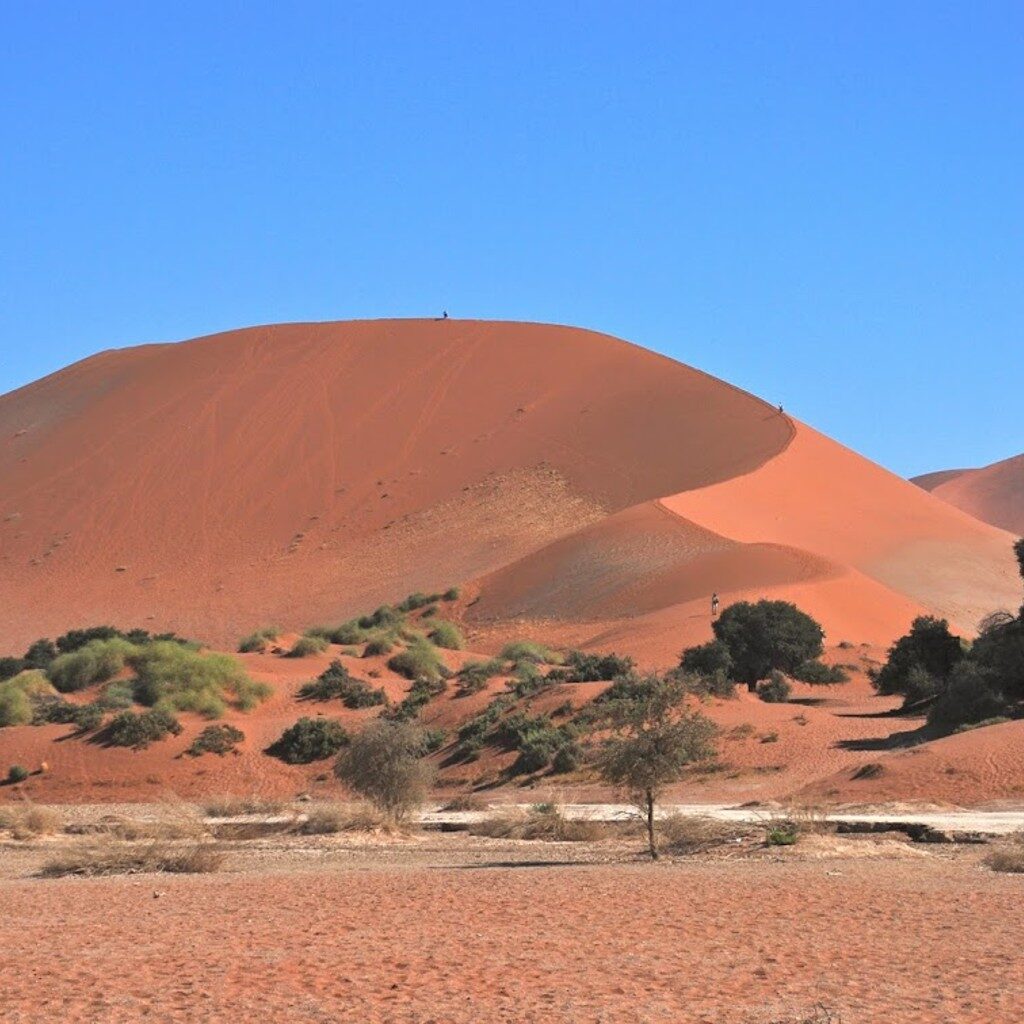
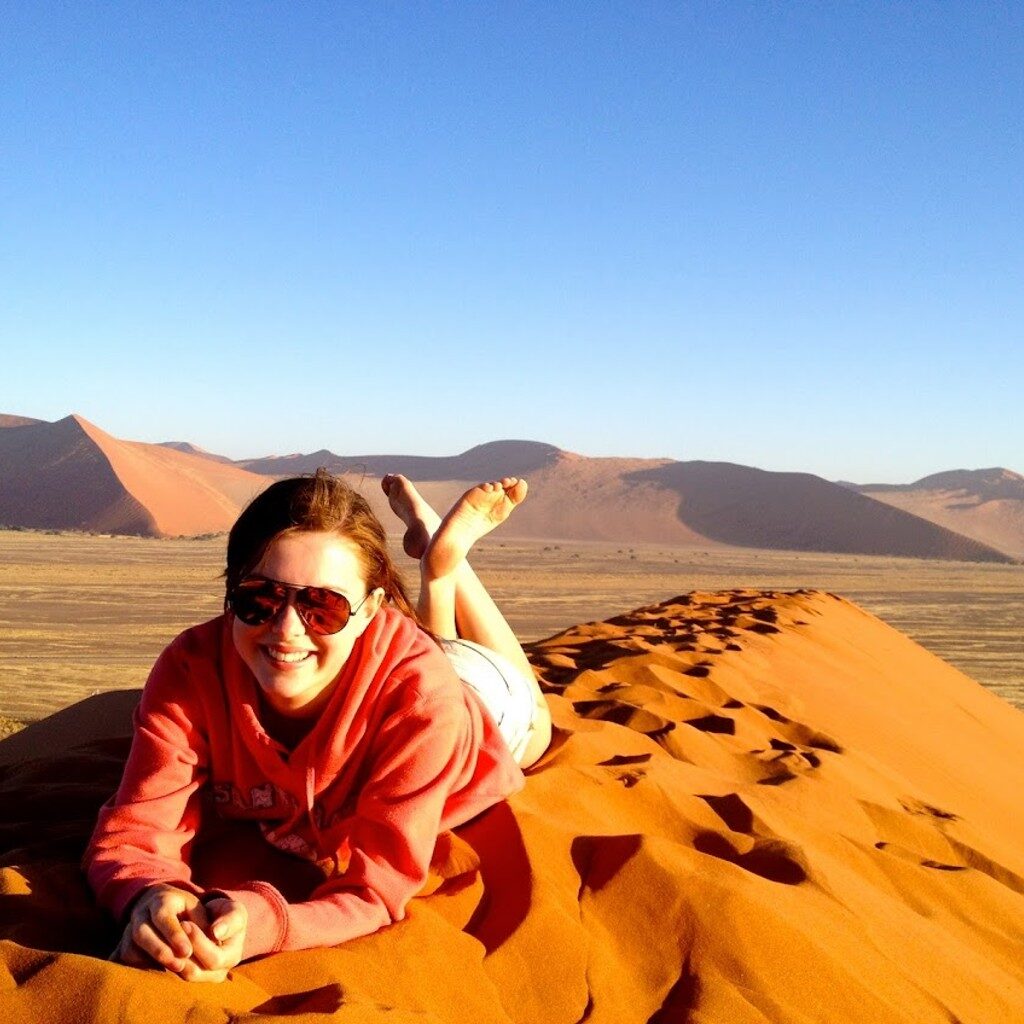
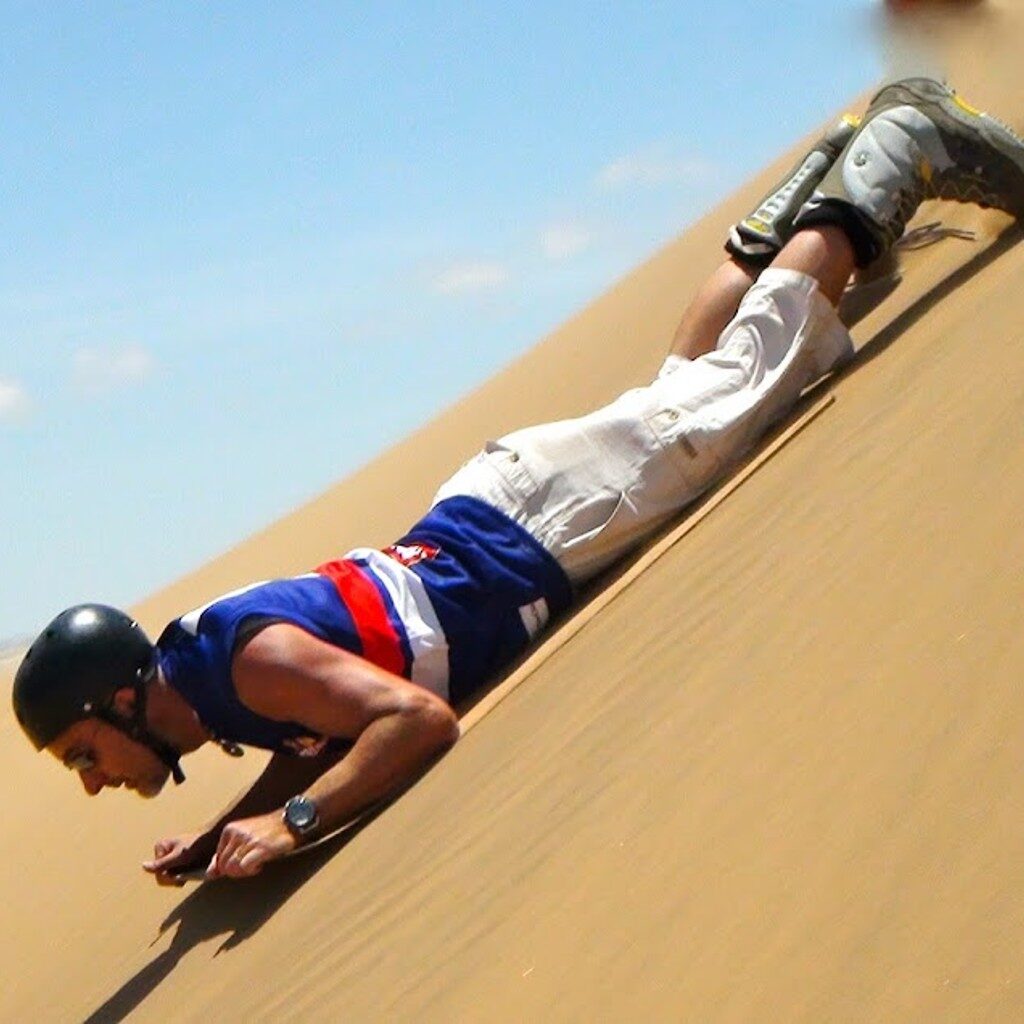
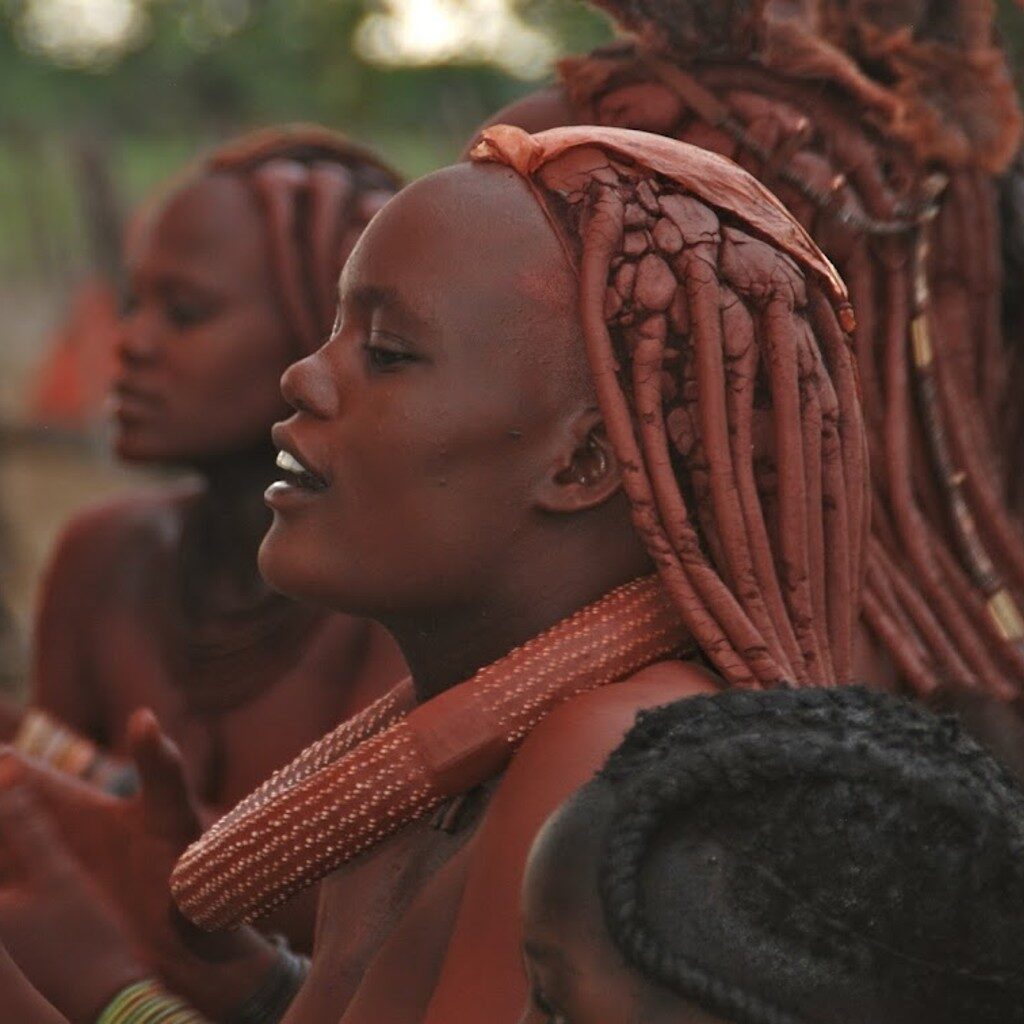
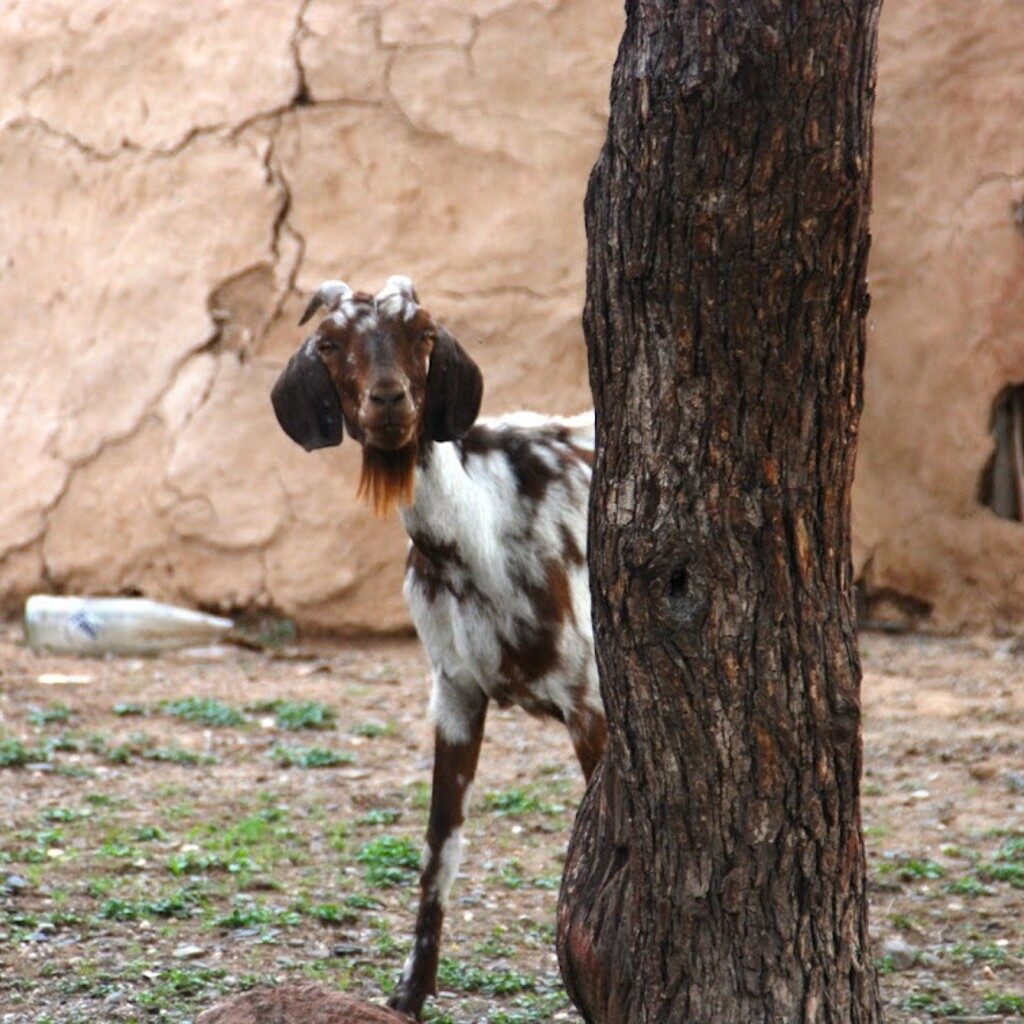
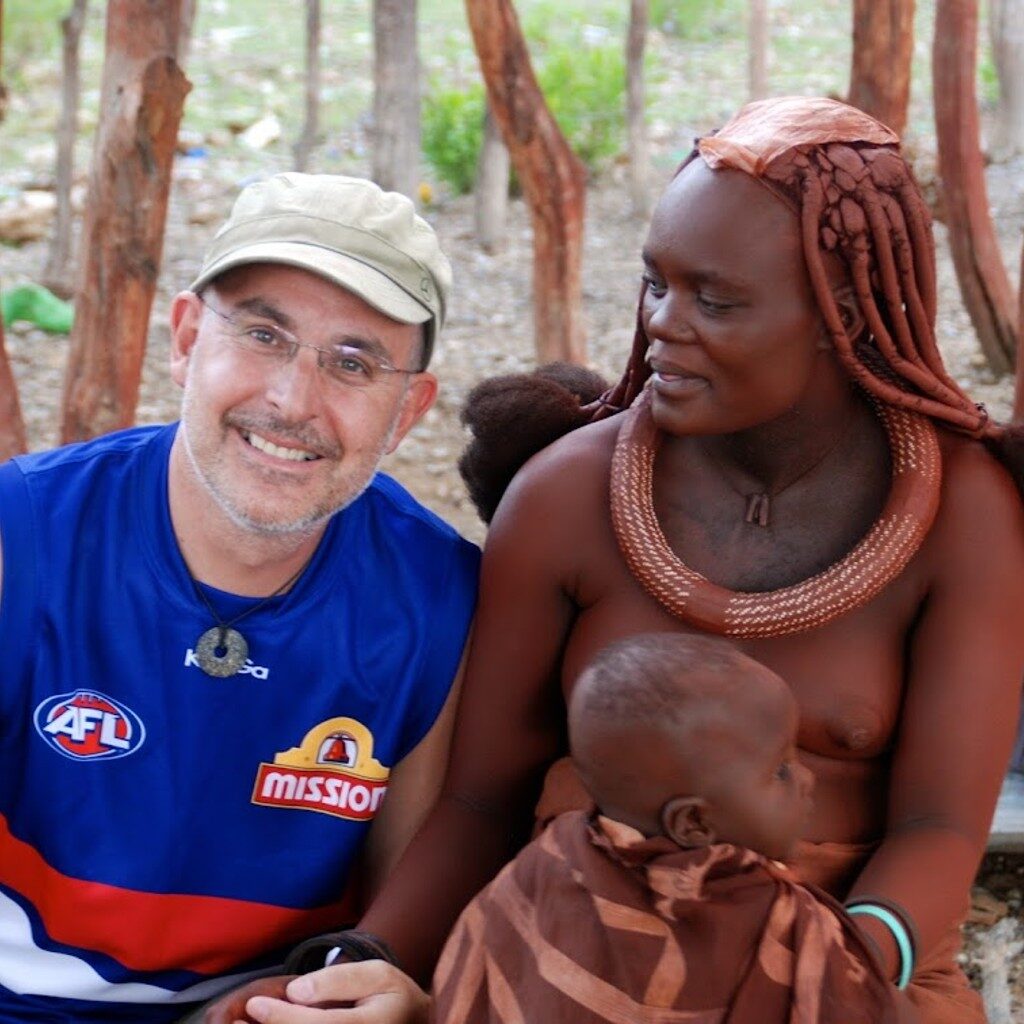
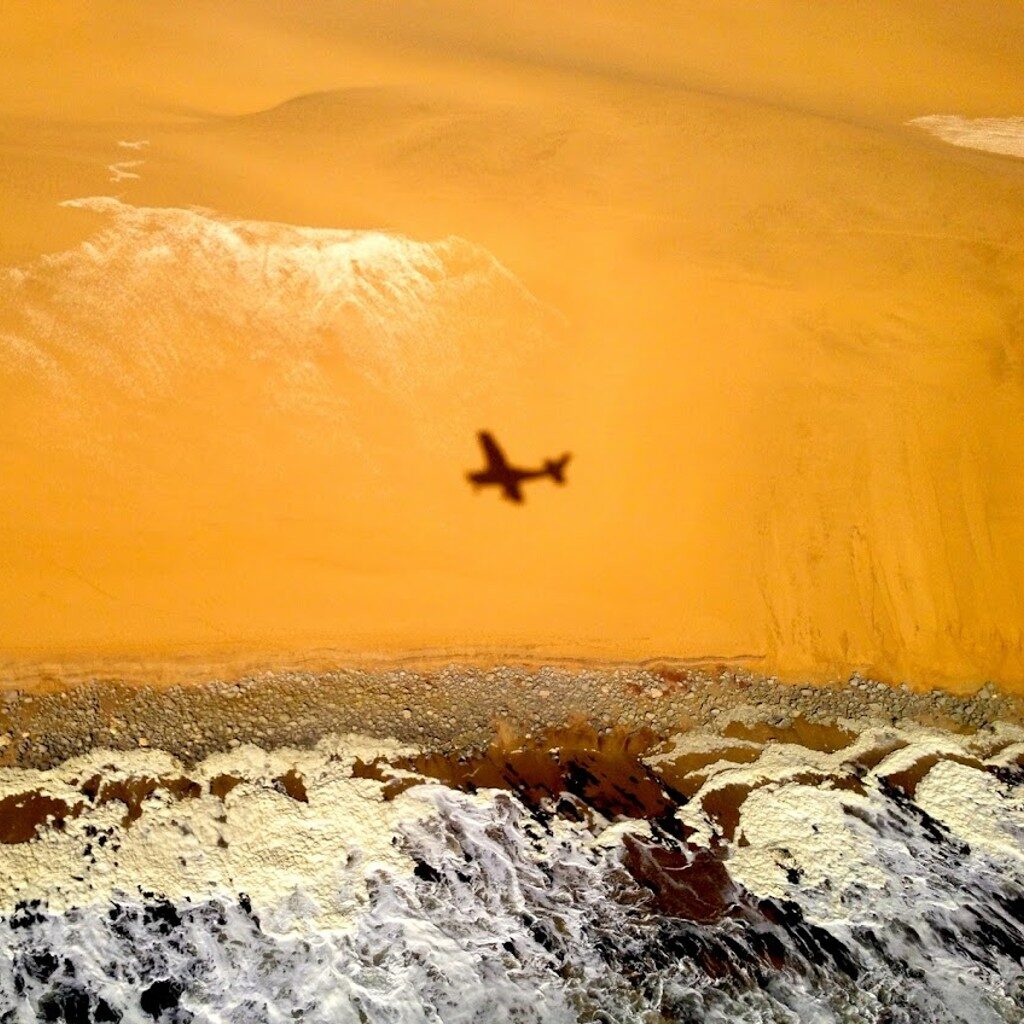
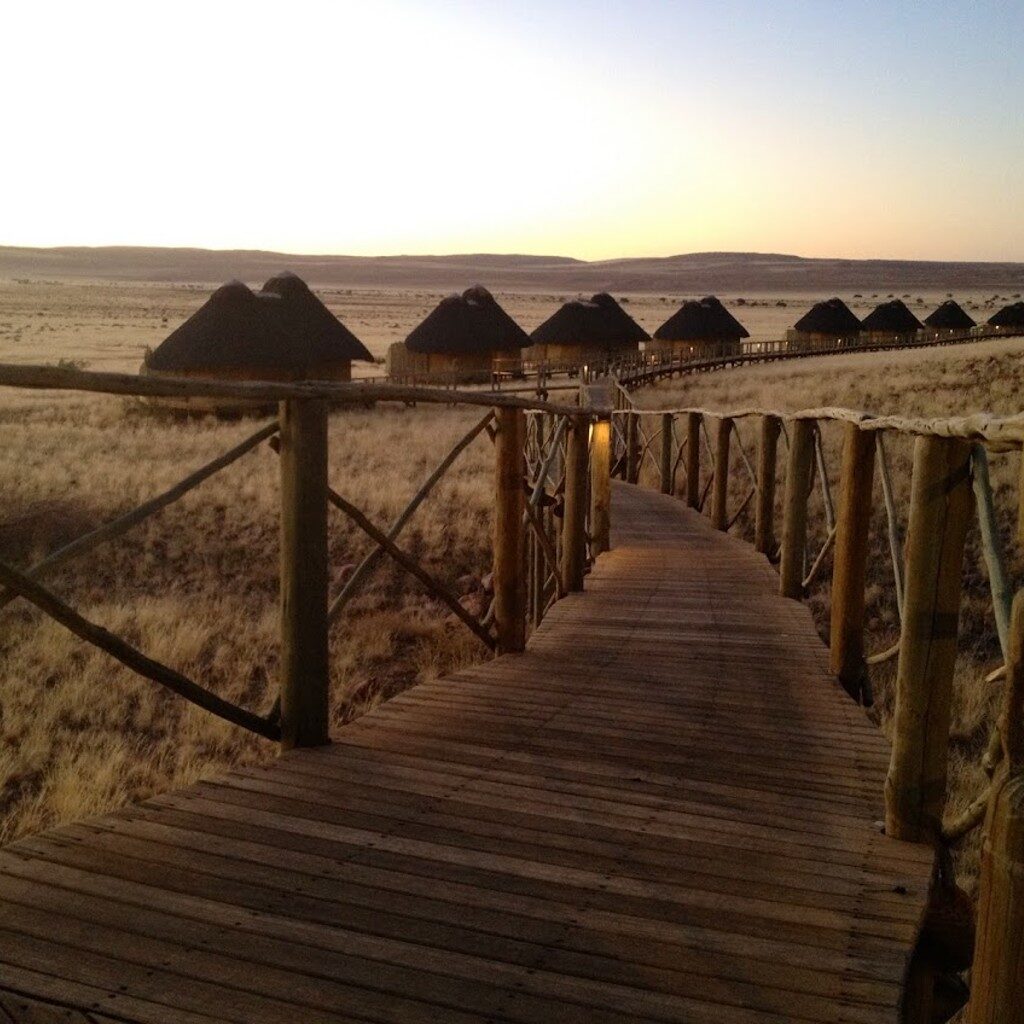
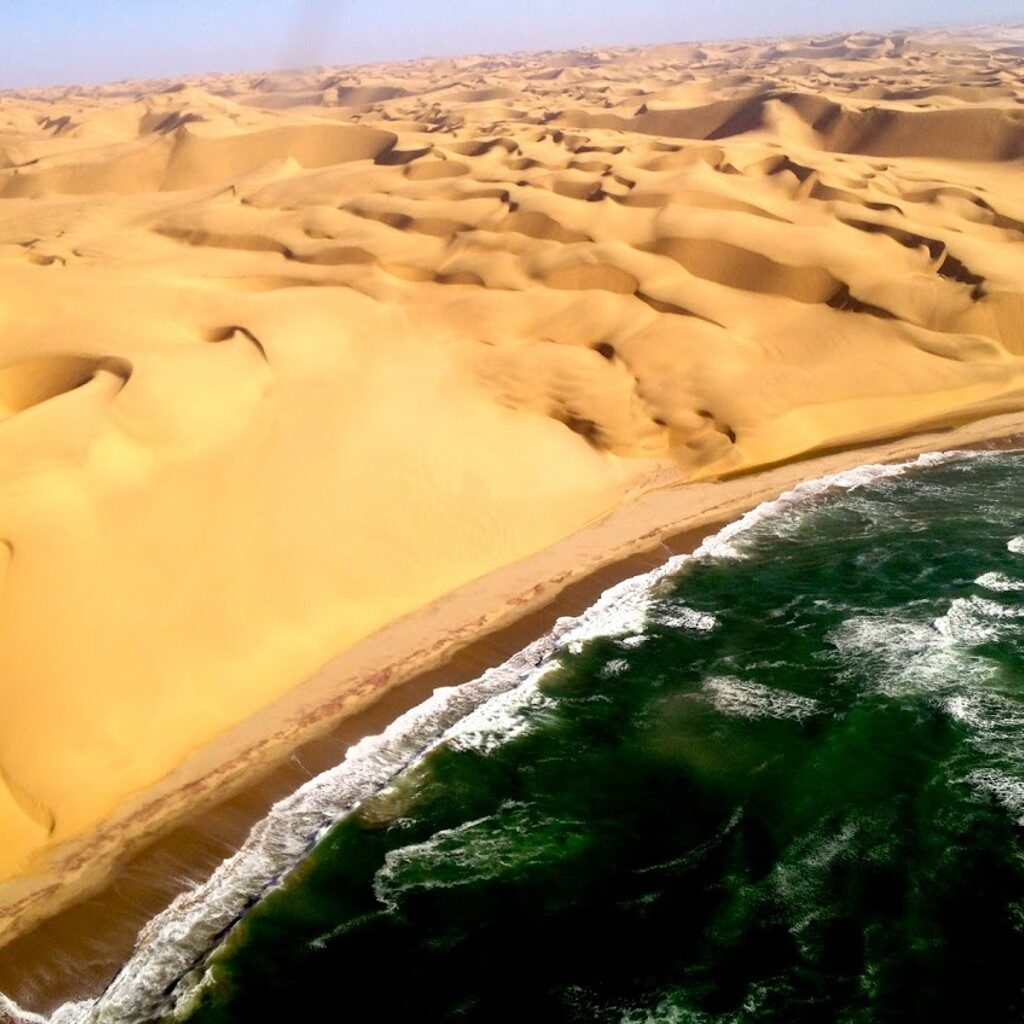
Her only clothing was a simple loincloth made of the softest goatskin. The end result was quite striking as she emanated a rich red brown glow in the morning light. In contrast, despite an armful of bracelets and a smattering of ochre on my cheeks, I looked particularly down market in my well-worn three quarter pants and blue singlet.
She leaned over to me, touched my hand and indicated that it was time to move on, that very quickly broke the illusion as I’d forgotten how much she smelt, not just a slight odour, but the type of smell you normally associate with a dead possum in the roof. I remembered that the otjize not only protected her skin against the harsh desert climate but also supplemented ever having to wash.
We eventually reached the water, which was nothing more than a hole in an apparently dry riverbed, where we filled our containers and to the amusement of onlookers I washed my face. I however wasn’t laughing as I struggled back to the village dragging the heavy water container behind me whilst my companion, way in front, elegantly and effortlessly balanced her container on her head. The only positive being the temporary relief from her pungent odour!
The Village
Other than the long yellow grass that waved all around me, I struggled to see any evidence of life in this harsh and unforgiving environment where the Himba are forced to live. The correct term is Ovahimba and they were originally part of the Herero tribe that dominates large parts of Angola, Botswana and Namibia. Over the centuries they dispersed and roamed freely with their cattle, which meant they fell victim to stronger better-organised tribes, and eventually were forced to survive by adopting a hunter-gatherer lifestyle. Today they live a nomadic existence, moving with their herds of goats and cattle to where they can find adequate grazing and a supply of fresh water.
As I approached the village a young girl, with a mischievous smile and two plaits hanging from her forehead ran up to me and relieved me of my heavy container.
The village was nothing more that a few round huts made of branches covered in mud surrounded by an organic fence constructed of mopane wood that seemed to flow naturally around the village. There was a small entrance, opposite, which stood the main hut, in front was the sacred fire, I was careful to respect tradition and walk behind the main hut and not cut across the sacred fire.
The Tribe
I spent the rest of the day playing with the children, learning how to crush maize for flour and hand churn butter. They tried to teach me how to make jewellery but I could barely see the holes in the beads let alone thread a wire through them. Once the sun had dropped behind the nearby peak and it started cooling down, we first collected firewood, then the women entertained me with some incredible rhythmic dancing that involved a lot of feet stamping and shrilling woops and whistles. When it was my turn to join in; even though I had no rhythm, style or idea what I was doing, my spinning, ducking and weaving, impressed them. Little did they know that this was all aimed at avoiding a low flying breast.
Dinner was a social affair around the fire eating a strange concoction made of maize flour and goats milk, being a married man I was also afforded the luxury of some of the sacrificed goat meat. The tribe was content to sit up and chat for hours, but exhausted I slipped away and retreated to my hut. After a long day the smooth earth floor felt like a five star hotel mattress and the rough blankets like 1200 count sheets. I drifted off to the purring of the baby-orphaned cheetah that had adopted me, the gentle nibbling of my toes a nice final memory before nodding off.
The Dune
I woke from my Himba dream with a jolt as a harsh American accent announced that we had reached the dune. I peered out of the window of the van and looked up at this massive 100-metre dune rising above the plain. At the foot of it were rows of snowboards and next to them a box of boots. We divided into two groups, had a quick lesson on how to wax our boards between every run and I amongst the other ‘experts’ trudged up the dune. Walking on a sand dune is difficult at any time; add to this the fact you are wearing snowboard boots, a board under one arm, a forty knot wind blowing sand in your face and the desert heat and you soon wonder why you paid good money for this activity. However after you get the hang of it the sheer thrill of riding a sand dune for 30 seconds soon outweighs the strenuous 20-minute climb back up.
Sandboarding came to Namibia in 1996 and is one of numerous activities that you can do out of Swakopmund, an unusual town the straddles the Namib Desert and the Atlantic Ocean. There is a strong German influence in town, cake shops line the main street and our hotel was straight out of Bavaria. In recent years it has become an adventure hub, only the day before we donned helmets and explored the dunes on quad bikes. We passed up on jumping out of a perfectly serviceable aircraft but we couldn’t leave town without trying body surfing on the dunes.
It’s a very simple but potentially dangerous activity. Due to a lack of time we only did it once but that one time was on the longest run on the highest dune with the ominous name of Big Dog Daddy. I’ll try to describe the training, the execution and the run in as much detail as I can.
1. The Training – lie on piece of Masonite head first, elbows down, lift front of board, keep feet raised slightly
2. The Execution – Next, ready, go, push.
3. The Run – FAAAAAAAAAAAARRRRRKKKKK 10 seconds, 72 kph, all over.
The Lodge
There is more to Namibia than just sand dunes, there is desert and there are more sand dunes. We decided to treat ourselves and end what had been an incredibly full year with a couple of nights in the Sossus Dune Lodge. A magnificent five star lodge that was made up of a long line of chalets linked by raised wooden walkways and constructed from rock and stone found locally. All of the chalets had a large en-suite bathroom, complete with a hot shower, double basin and a flush toilet. They were equipped with mosquito nets, solar powered lights and fans, environmentally friendly soaps, shampoo, body lotion etc. Every room was furnished with leather and dark wood furniture and suede lounges. The front of the chalets had floor-to-ceiling glass, with fantastic views of the surrounding desert. I paraphrased most of this off their brochure, but you get the drift – it was bloody nice! Despite it’s obvious assets, the best part was the lodges’ location – inside the park gates which meant first access to the world famous Dune 45.
The Famous Dune
We were woken at 3:30am on New Years Day by a loud knock on the door. We scrambled to get our gear together, jumped in the 4WD and raced toward the dune. A few minutes down the road and we could already see some headlights in the distance behind us. Arriving at the dune, it was still dark and taking off our shoes, the sand felt cold beneath our feet. Sheridan and I raced up the massive dune like Thomson’s gazelles determined to be the first people to witness the first sunrise of the year. It was hard going as each step broke into virgin sand; the dunes’ edge less than a centremetre wide and raked steeply on each side. Just when you thought you had reached the peak another ridgeline appeared. Finally just before the sun emerged over a nearby dune, we reached the top. The view was incredible and for a moment we were alone, each minute after that we were joined by another climber, they would reach the summit, nod, find an empty spot and just stare. The silence was eventually broken when a French tourist pulled out his saxophone and gave us a special Kenny G moment, right there in the middle of the desert on New Years Day. We had hoped to crack open the bottle of champagne that our friends had brought with them from France, until we realized that Michelle had it in her day pack and looking down we could just see her, sitting halfway up the dune content with the view from the safety of her chosen position.
The Flight
Not content with just climbing the dunes, we tracked down a local pilot who took us for a flight over the dunes. Expecting a short scenic flight over a bit of desert we were blown away by what was below us. For an hour we flew over some incredible landscape, every dune a different shape and ranging in tones from pale yellow, through bright orange to an intense red. The highlight was a run along the coast where dropping to only 2 metres above the waves we watched as a jackal stalked a seal as it struggled to shore. This was the only sign of life in this whole area of uninhabited, starkly beautiful wilderness. Back at the lodge I reviewed the photos on my iPhone and couldn’t believe the results.
The Dream
As I drifted to sleep I just lay there recalling what an incredible first day of the year we just had, asking myself if it can get any better than this?
I had trouble sleeping as luxury bed linen can be a tad heavy and there was no air conditioning, which was rather annoying.
Tossing and turning, at one stage in the middle of the night I woke up to a pungent smell and wet toes. Confused, I tentatively got out of bed, put the supplied cotton slippers on and quietly tip toed across the smooth polished floorboards to the en-suite bathroom. Switching on the light I peered closely in the delicately framed mirror and noticed dark shadows on my face. I tentatively touched my cheek and was surprised to find that I had red ochre on my fingers.
I smiled and thought back to my Himba friends in the desert who were probably also living the dream.
Copyright © Reho Travel 2024. All rights Reserved